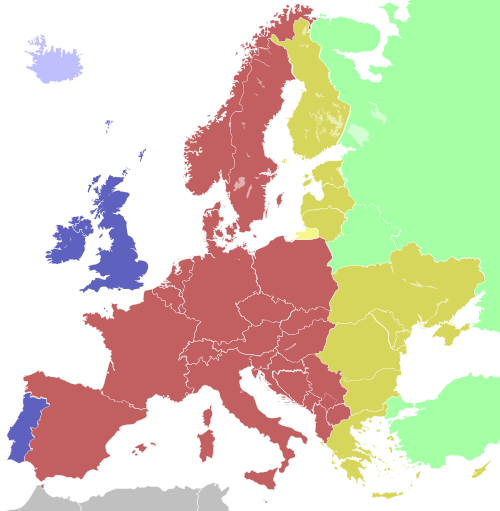Greenwich Mean Time

| blue | Western European Time (UTC+0) Western European Summer Time (UTC+1) |
| light blue | Western European Time (UTC+0) |
| red | Central European Time (UTC+1) Central European Summer Time (UTC+2) |
| yellow | Eastern European Time (UTC+2) Eastern European Summer Time (UTC+3) |
| orange | Kaliningrad Time (UTC+3) |
| green | Moscow Time (UTC+4) |
Greenwich Mean Time (GMT) is an internationally standardized time format. It is the main time zone in several countries, including the United Kingdom, the Republic of Ireland and Portugal. GMT has the same time as UTC, but there are differences between the two.[1] Technically, GMT is a time zone, while UTC is a time standard.
GMT was established in 1884 at the International Meridian Conference,[2] which met to establish a standardized system for measuring world longitude. They decided that the meridian passing through the Royal Observatory in Greenwich, England would be 0° longitude[3].This conference also decided that the time zone around the meridian, GMT, would be the time zone used for reference around the world. Other countries would define their time based on GMT.
UTC was defined in 1963 as the new world reference for time.[4] The major advantage of the new standard was that its time was determined by highly accurate atomic clocks, not the sun at Greenwich. Other advantages of UTC are that calling the new standard Coordinated Universal Time avoids giving more importance to any one country, and that UTC does not adjust for Daylight Saving Time, which means the world always has a standard time.
Greenwich Mean Time Media
The Shepherd Gate Clock at the gates of the Royal Observatory, Greenwich is permanently kept on Greenwich Mean Time.
References
- ↑ "UTC & GMT – Same Difference?". www.timeanddate.com. Retrieved 2021-03-11.
- ↑ "GMT vs. UTC. What's the difference?". 24timezones.com. Retrieved 2021-03-11.
- ↑ "What is the Prime Meridian and why is it in Greenwich?". www.rmg.co.uk. Retrieved 2021-03-11.
- ↑ "Coordinated Universal Time". Wikipedia. 2021-03-11.

